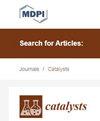在 g-C3N4/TiO2 异质结中实现高效电子转移以增强光催化二氧化碳还原能力
IF 3.8
3区 化学
Q2 CHEMISTRY, PHYSICAL
引用次数: 0
摘要
二氧化碳的过度排放导致了温室效应和全球变暖。通过太阳能将二氧化碳还原成高附加值化学品是一种前景广阔的方法。本文设计了一种具有高效电子传递功能的 g-C3N4/TiO2 异质结光催化剂,用于光催化还原二氧化碳。g-C3N4/TiO2 的 CH4(18.32 µmol-h-1-g-1)和 CO(25.35 µmol-h-1-g-1)演化率高于 g-C3N4 和 TiO2。光催化还原 CO2 性能的提高归功于 g-C3N4/TiO2 异质结中高效的电荷载流子转移。原位辐照 X 射线光电子能谱(XPS)验证了电子转移途径。通过原位漫反射红外傅里叶变换光谱(DRIFTS)研究了 g-C3N4/TiO2 光催化还原 CO2 的机理。这项研究为设计具有高效电子传递功能的聚合物/金属氧化物异质结以增强光催化还原 CO2 提供了一种策略。本文章由计算机程序翻译,如有差异,请以英文原文为准。
Efficient Electron Transfer in g-C3N4/TiO2 Heterojunction for Enhanced Photocatalytic CO2 Reduction
Excessive emissions of carbon dioxide have led to the greenhouse effect and global warming. Reducing carbon dioxide into high-value-added chemicals through solar energy is a promising approach. Herein, a g-C3N4/TiO2 heterojunction photocatalyst with efficient electron transfer is designed for photocatalytic CO2 reduction. The CH4 (18.32 µmol·h−1·g−1) and CO (25.35 µmol·h−1·g−1) evolution rates of g-C3N4/TiO2 are higher than those of g-C3N4 and TiO2. The enhanced photocatalytic CO2 reduction performance is attributed to the efficient charge carrier transfer in the g-C3N4/TiO2 heterojunction. The electron transfer route was verified by in situ irradiated X-ray photoelectron spectroscopy (XPS). The photocatalytic CO2 reduction mechanism on g-C3N4/TiO2 was investigated by in situ diffuse reflectance infrared Fourier transform spectroscopy (DRIFTS). This work provides a strategy for designing a polymer/metallic oxide heterojunction with efficient electron transfer for enhanced photocatalytic CO2 reduction.
求助全文
通过发布文献求助,成功后即可免费获取论文全文。
去求助
来源期刊

Catalysts
CHEMISTRY, PHYSICAL-
CiteScore
6.80
自引率
7.70%
发文量
1330
审稿时长
3 months
期刊介绍:
Catalysts (ISSN 2073-4344) is an international open access journal of catalysts and catalyzed reactions. Catalysts publishes reviews, regular research papers (articles) and short communications. Our aim is to encourage scientists to publish their experimental and theoretical results in as much detail as possible. Therefore, there is no restriction on the length of the papers. The full experimental details must be provided so that the results can be reproduced.
 求助内容:
求助内容: 应助结果提醒方式:
应助结果提醒方式:


